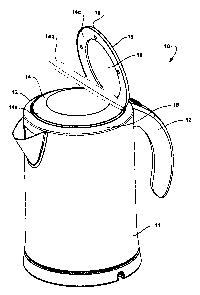Une partie des informations de ce site Web a été fournie par des sources externes. Le gouvernement du Canada n'assume aucune responsabilité concernant la précision, l'actualité ou la fiabilité des informations fournies par les sources externes. Les utilisateurs qui désirent employer cette information devraient consulter directement la source des informations. Le contenu fourni par les sources externes n'est pas assujetti aux exigences sur les langues officielles, la protection des renseignements personnels et l'accessibilité.
L'apparition de différences dans le texte et l'image des Revendications et de l'Abrégé dépend du moment auquel le document est publié. Les textes des Revendications et de l'Abrégé sont affichés :
| (12) Brevet: | (11) CA 2504052 |
|---|---|
| (54) Titre français: | BOUILLOIRE AVEC MECANISME AMORTISSEUR DE COUVERCLE |
| (54) Titre anglais: | KETTLE WITH LID DAMPING MECHANISM |
| Statut: | Accordé et délivré |
| (51) Classification internationale des brevets (CIB): |
|
|---|---|
| (72) Inventeurs : |
|
| (73) Titulaires : |
|
| (71) Demandeurs : |
|
| (74) Agent: | SMART & BIGGAR LP |
| (74) Co-agent: | |
| (45) Délivré: | 2013-05-28 |
| (22) Date de dépôt: | 2005-04-11 |
| (41) Mise à la disponibilité du public: | 2005-10-19 |
| Requête d'examen: | 2010-04-06 |
| Licence disponible: | S.O. |
| Cédé au domaine public: | S.O. |
| (25) Langue des documents déposés: | Anglais |
| Traité de coopération en matière de brevets (PCT): | Non |
|---|
| (30) Données de priorité de la demande: | ||||||
|---|---|---|---|---|---|---|
|
Récipient avec couvercle à charnière. Le couvercle à charnière est placé de biais, en position ouverte, à l'aide d'un ressort. Le couvercle est raccordé de façon mécanique à un mécanisme amortisseur, préférablement dissimulé dans le corps ou le couvercle du récipient. Le couvercle est maintenu en position fermée par un verrou.
A vessel has a hinged lid. The hinged lid is biased into an open position by a spring. The lid is mechanically coupled to a damping mechanism, preferably concealed within the body or lid of the vessel. The lid is held in a closed position by a latch.
Note : Les revendications sont présentées dans la langue officielle dans laquelle elles ont été soumises.
Note : Les descriptions sont présentées dans la langue officielle dans laquelle elles ont été soumises.

2024-08-01 : Dans le cadre de la transition vers les Brevets de nouvelle génération (BNG), la base de données sur les brevets canadiens (BDBC) contient désormais un Historique d'événement plus détaillé, qui reproduit le Journal des événements de notre nouvelle solution interne.
Veuillez noter que les événements débutant par « Inactive : » se réfèrent à des événements qui ne sont plus utilisés dans notre nouvelle solution interne.
Pour une meilleure compréhension de l'état de la demande ou brevet qui figure sur cette page, la rubrique Mise en garde , et les descriptions de Brevet , Historique d'événement , Taxes périodiques et Historique des paiements devraient être consultées.
| Description | Date |
|---|---|
| Représentant commun nommé | 2019-10-30 |
| Représentant commun nommé | 2019-10-30 |
| Accordé par délivrance | 2013-05-28 |
| Inactive : Page couverture publiée | 2013-05-27 |
| Inactive : Taxe finale reçue | 2013-03-18 |
| Préoctroi | 2013-03-18 |
| Un avis d'acceptation est envoyé | 2012-10-03 |
| Lettre envoyée | 2012-10-03 |
| Un avis d'acceptation est envoyé | 2012-10-03 |
| Inactive : Approuvée aux fins d'acceptation (AFA) | 2012-10-01 |
| Modification reçue - modification volontaire | 2012-06-18 |
| Inactive : Dem. de l'examinateur par.30(2) Règles | 2011-12-19 |
| Modification reçue - modification volontaire | 2010-09-20 |
| Lettre envoyée | 2010-04-22 |
| Exigences pour une requête d'examen - jugée conforme | 2010-04-06 |
| Requête d'examen reçue | 2010-04-06 |
| Toutes les exigences pour l'examen - jugée conforme | 2010-04-06 |
| Inactive : CIB de MCD | 2006-03-12 |
| Inactive : CIB de MCD | 2006-03-12 |
| Inactive : CIB de MCD | 2006-03-12 |
| Demande publiée (accessible au public) | 2005-10-19 |
| Inactive : Page couverture publiée | 2005-10-18 |
| Inactive : CIB en 1re position | 2005-08-17 |
| Lettre envoyée | 2005-06-20 |
| Inactive : Transfert individuel | 2005-06-08 |
| Inactive : Lettre de courtoisie - Preuve | 2005-05-24 |
| Exigences relatives à une correction du demandeur - jugée conforme | 2005-05-17 |
| Exigences de dépôt - jugé conforme | 2005-05-17 |
| Inactive : Certificat de dépôt - Sans RE (Anglais) | 2005-05-17 |
| Demande reçue - nationale ordinaire | 2005-05-16 |
Il n'y a pas d'historique d'abandonnement
Le dernier paiement a été reçu le 2013-03-18
Avis : Si le paiement en totalité n'a pas été reçu au plus tard à la date indiquée, une taxe supplémentaire peut être imposée, soit une des taxes suivantes :
Veuillez vous référer à la page web des taxes sur les brevets de l'OPIC pour voir tous les montants actuels des taxes.
Les titulaires actuels et antérieures au dossier sont affichés en ordre alphabétique.
| Titulaires actuels au dossier |
|---|
| BREVILLE PTY. LTD. |
| Titulaires antérieures au dossier |
|---|
| GERARD WHITE |